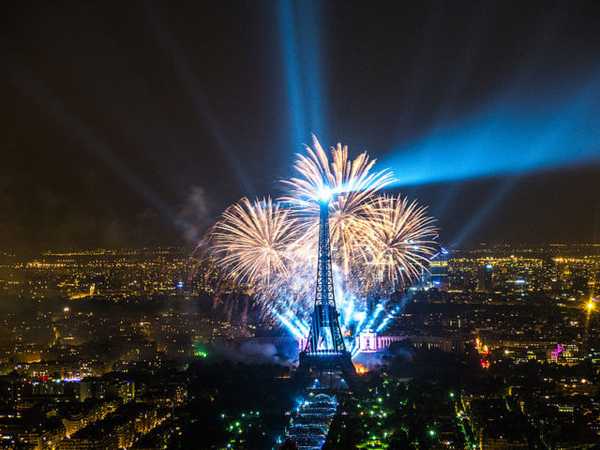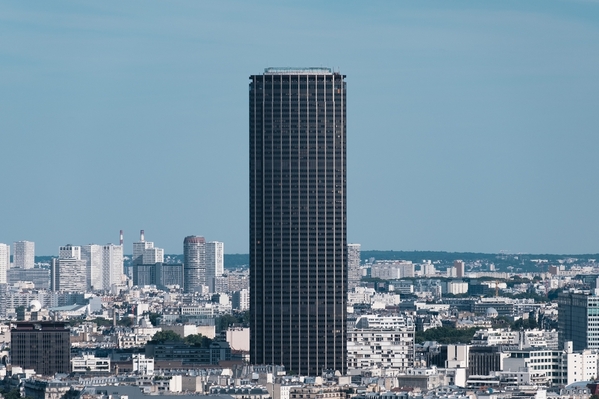I need to start with a personal note here: The French writer Guy de Maupassant was one of the campaigners against the Eiffel Tower, as was Charles Garnier, architect of the Paris Opera. When it was finished, de Maupassant ate lunch each day in a restaurant at the tower, explaining it was the only place in Paris from which he did not see it.
 Bastille Day fireworks, from Tour Montparnasse (Yann Caradec, Wikimedia)
Bastille Day fireworks, from Tour Montparnasse (Yann Caradec, Wikimedia)
Certainly not how nearly all of us would see it today, right? Well, for some of use, the Montparnasse Tower, the Tour Montparnasse inspires that kind of feeling today. Doesn't exactly play well with others, or grace the skyline. In 2008, a panel voted it the second-ugliest building in the world, after Boston's City Hall. A new project, about to begin, will completely redesign the exterior, but it will still stick up like a sore thumb, especially since its construction led to a new zoning law prohibiting buildings over seven stories in central Paris.
But, despite my distaste for the building, it clearly has one big thing going for it: one heck of a view over Paris and its surroundings, in some cases with much clearer views from less-crowded observation points than at the Eiffel Tower. So, here's a gallery of views taken last September.
The building owes its existence to a 1960s decision to build a new Gare Montparnasse, the glass structure in the first photo above. The station was built a ways further down the tracks, leaving eight hectares of land open for the tower and auxiliary buildings.
In addition to the long-distance and regional trains headed to the station, the tower gives a look at one of the more unusual stretches of Metro, an elevated part of Line 6, with glass-roofed stations every few blocks. That's Sèvres-Lecourbe in the foreground.
My visit came at a good time to observe some 'monumental construction,' with scaffolding up on one side of the Eiffel Tower for painting and maintenance, and the Arc de Triomphe temporarily wrapped in silvery plastic for an art event designed by the late artist Christo and his wife Jeanne-Claude.
The viewing platform itself had few visitors; between a steep price, a chilly day and Covid, business was slack. There are two viewing levels, one above the other but the lower one has no openings in the glass. I have a nearly duplicate set of images made from there before I discovered the open sections of the upper floor. The device just above is part of an automated scaffolding system for maintenance and window-washing.
Nearly all the city's monuments and memorable buildings are easily seen, with some interesting foreshortening from using a significant telephoto lens.
Below, the art museums. First, the glass topped Grand Palais and Petit Palais just past the pillars of the Alexandre III Bridge, then the amazingly long Louvre, and the hardly-recognizable from behind Musée d'Orsay.
A little further over, facing what was once Les Halles in fact as well as name, is the Eglise Saint-Eustache, and then a bit east of that the building that will, thanks to its design, never appear to be finished: the Centre Pompidou.
And a new construction project, one that might almost give the Montparnasse tower a run for the money for ugly. These twisted buildings, the Tours Duo, are part of a new business district at the outer edge of the 13e arrondissement
The height and location also provide interesting angles and views of some more ordinary, or perhaps a better word is 'typical' structures around the tower.
But perhaps, in the end, the most unusual view from the tower is the one straight down into Montparnasse Cemetery, the city's second largest. It has around 40,000 graves and one of the few remaining windmills in Paris, a remnant from its days as farmland before 1824.




Comments (0)